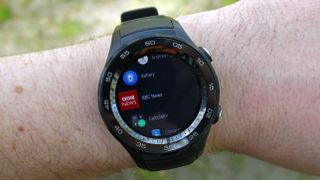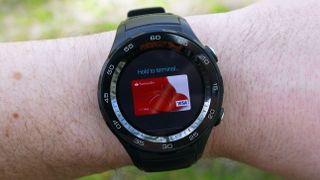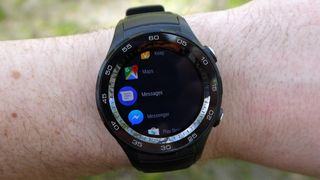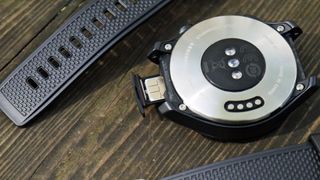Why you can trust TechRadar
Specs and interface
- Sluggish performance
- Useful security PIN feature
- On-watch app store
The Huawei Watch 2 packs a Snapdragon Wear 2100 chipset which has been specifically made for wearables, along with 768MB of RAM.
In short, it’s not enough. The Huawei Watch 2 feels sluggish, with slow transitions between watch faces and menus.
The main issue here though is the lag in opening apps. You can program the lower physical key on the right of the watch to launch a specific app – a handy shortcut if there’s one feature you frequently use, as it saves you from navigating the still slightly clunky Android Wear 2.0 menu.
We say Android Wear 2.0 (and we keep refering to it as that throughout this review) but you'll find it's now running the rebranded version of that software that's called Wear OS.

This hardware key is set to the Workout fitness app by default, but we chose to change this to Android Pay as we’re suckers for convenient contactless payments… trouble is, on the Huawei Watch 2 it’s not always that convenient.
There’s a noticeable delay between you pressing the button and Android Pay loading up on screen, and this becomes troublesome if you’re in a queue of people trying to pay for a coffee or get through barriers at a train statio – morning commuters are unforgiving, and the Huawei Watch 2’s stuttering performance will win you no friends.
This issue can in theory be overcome with a little bit of pre-planning – so you’d hit the button in advance of reaching the payment point – but this didn’t always solve our problems.

On several occasions Android Pay refused to work at all. We haven’t experienced the same issue with our phone or contactless bank card, and the fact the Huawei Watch 2 refused to play ball on a number of occasions during our review period does raise some questions.
Hopefully this intermittent bug can be ironed out with a software update, but coupled with the less-than-slick operation it makes for a frustrating experience.
The fact there’s no rotating bezel (as on the Samsung Gear S3) or rotating crown (as on the LG Watch Sport) makes scrolling through things like menus a little trickier, as your finger spends most of the time covering the screen.
Considering that Google has designed Android Wear 2.0 to play nicely with these rotating elements it’s a shame Huawei hasn’t included something on the Watch 2.
The watch still includes Android Wear 2.0 features, but the software has since been renamed Wear OS. That's in an attempt from Google to make it clear watches running the software work with both iPhones and Google devices.

It’s good to see Google’s latest operating system in action on another smartwatch though, and its self-locking mode when you remove your device from your wrist is useful. It means that if someone was to steal your watch they’d need your PIN to use it, so they couldn’t go on a spending spree with Android Pay – assuming it actually worked, that is.
Another big feature of the Android Wear 2.0 update was the dedicated app store on the watch itself. This means you can download apps directly to the watch, without the need to go to your smartphone and download it on there first.
Big hitters such as Spotify, Uber, WhatsApp and Facebook Messenger feature in the watch-based Play Store, but as with all Android Wear devices there’s still a limited number of apps to choose from.
As with other interactions, navigating the Play Store is tricky on the small screen of the Huawei Watch 2, which again makes us wish for a larger display and physical rotating input.
There’s 4GB of storage on the Watch 2, allowing you to download a number of applications.
Annoyingly there’s no obvious way to check how much space you have left, although we managed to comfortably download 10 apps onto the Huawei Watch 2 from the Play Store – on top of the pre-loaded offerings – without issue.

4G features
- Make/receive calls, send messages, using web without phone
- Second SIM contract required
- Limited use-cases for the price you pay
The Huawei Watch 2 functions perfectly well without a SIM card, using either your smartphone’s internet connection or that of a local Wi-Fi network to provide you with your news, Ubers, music and more.
It’s for the rare occasions when you’re 1) not with your phone and 2) not around a Wi-Fi network that the Huawei Watch 2 comes into its own.
In these situations most smartwatches are far less useful, but the Huawei Watch 2 is here to help, with a nanoSIM slot hiding behind one of the straps (you’ll have to remove the strap to access the port) providing you with that all-important connection.

This can be useful if you’re into fitness and outdoor activities where you wouldn’t want to take your phone with you. The SIM card allows you to make and receive calls, send and receive text messages and mess around with all your web-dependent apps.
Thing is, a second SIM means a second payment plan for those in the UK (remember, the 4G variant isn't coming to the US), which will likely put many people off – especially if they’re never that far from their phone. You’ll also have a second number for your watch, which isn’t particularly convenient for anyone trying to get in contact with you.
Make a call when you’re connected via Bluetooth to your phone, though, and your calls will use your main number, rather than the secondary one linked to the SIM in the Huawei Watch 2.

Compatibility
- Works with any Android phone running Android 4.3 and up
- Lesser functionality with iPhones running iOS 9 and up
The Huawei Watch 2 works with all Android smartphones running Android 4.3 and above, with the full compliment of features available to you whether it’s a budget phone or premium flagship in your pocket.
It’s not just the Android Army that can use the Huawei Watch 2, though, with the Wear OS app also available on iPhone. You’ll also need an iPhone 5 or newer running at least iOS 9.
Notifications don’t have as many actions, which means you’ll find yourself unable to respond to things such as WhatsApp messages, and you’ll find some apps won’t play ball.
There’s no iMessage support, while email and calendar syncing can prove tricky. In short, an Apple Watch will likely cover your needs better than the Huawei Watch 2.
Current page: What’s it like to use?
Prev Page Introduction, design and display Next Page Fitness and battery life
John joined TechRadar over a decade ago as Staff Writer for Phones, and over the years has built up a vast knowledge of the tech industry. He's interviewed CEOs from some of the world's biggest tech firms, visited their HQs and has appeared on live TV and radio, including Sky News, BBC News, BBC World News, Al Jazeera, LBC and BBC Radio 4. Originally specializing in phones, tablets and wearables, John is now TechRadar's resident automotive expert, reviewing the latest and greatest EVs and PHEVs on the market. John also looks after the day-to-day running of the site.

